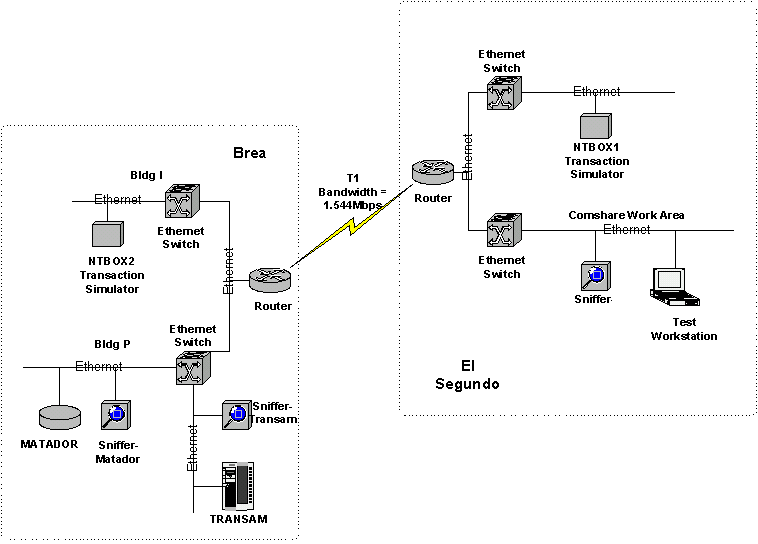1.
Definition of Problem
While the performance problems are numerous,
Richard Kimble and Rob Bent helped to identify three specific ones that
tests results can be analyzed more easily:
-
Web Logon
The delay between entering of the user ID and password and the
display of the following web page is lengthy.
Sometimes it is over a minute.
-
View Manager Loading
This is part of the Comshare tool kit.
It is running as a client/server application.
The delay after View Manager has been launch before the
display of the next screen is very lengthy.
Sometimes stretches over a few minutes.
-
View Manager Ad Hoc Unlock
Likewise, the delay after the Unlock button has been clicked until
the lock button is displayed again lasted over a few minutes at
times.
2.
Network Data Path
Dataflow
-
Web Logon
Traffic goes from the Workstation to TRANSAM, the Application
Server. Then the
transaction goes between TRANSAM and MATADOR.
Then the data is returned to the Workstation from TRANSAM.
-
View Manager Loading
Traffic goes between the MATADOR, the Database Server and the
Workstation.
-
View Manager Ad Hoc Unlock
Traffic goes between the MATADOR, the Database Server and the
Workstation.
To isolate the source of the above problems, the
following equipment were deployed on the network:
El Segundo
- Transaction Simulator – NTBOX1
This performs periodic simulation of Web Logon transactions.
As a control, SQL Logon and Web access to home.brea.com
are also run periodically.
- Test Workstation (ilan-litton)
This performs manual testing of the Web Logon, View Manager Loading
and View Manager Ad Hoc Unlock.
- Sniffer – ilan-litton
This allows the capture of the traffic between the Test Workstation
and another device.

3.
Analysis of the Captured
Application Signature
A previous report, “Analysis of Network-Comshare
Client/Server Applications, issued on 7/26/01, covered both the View
Manager Loading and View Manager Ad Hoc Unlock signatures.
- View Manager Loading
This traffic signature indicates a majority of the delay is due to
the large number of frames transferred in this transaction.
Even under the circumstance that the T1 link is available
100% for this transaction, the best transaction time can be not less
than 60 seconds.
- Web Logon
Prior to 8/8/01, this transaction signature
displays 61 second delays due to MATADOR.
After 8/8/01, this transaction signature displays 40 second delays
by MATADOR.
- View Manager Ad Hoc Unlock
Prior to 8/8/01, this transaction signature displays 61 second
delays due to MATADOR.
After 8/8/01, this transaction signature displays 40 second delays
by MATADOR.
Many tests have been done between 8/3/01 and
8/7/01 to rule out that the 61second delays were due to:
- Network Congestions
- Microsoft NT NETLOGONs
- Other network activities
- Logon ID conflicts
3.
Analysis of the Transaction Simulations
Analysis of the transaction simulations performed
by NTBOX1 and NTBOX2 show the same 61 second delays prior to 8/8/01 and
40 second delays thereafter as exhibited in the (2) above.
4.
Conclusion
It is conclusive that there are 61 second delays
generated by MATADOR that caused the slow transactions seen by the Web
Logons and the View Manager Ad Hoc Unlock.
These 61 second delays are now 40 second delays.
They may be causing the delays in other parts of the application.
The SQL Logons that were run as a control in the
Transaction Simulators do not show the 61 second, and now, 40 second
delays. This leads to a
high degree of certainty that the delays are related specifically to the
Comshare SQL transactions.
|
